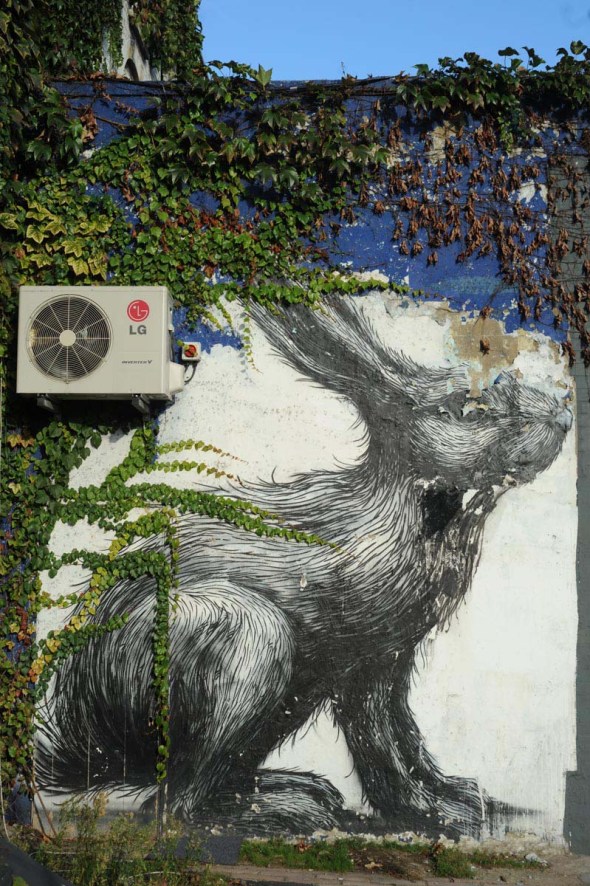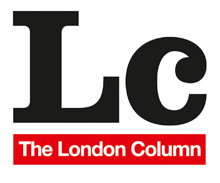On the natural history of gentrification.
Posted: October 7, 2014 Filed under: Class, Housing, London Types, Markets, Monumental, Public Art, Wildlife | Tags: animal art, Broadway Market, ha, Hackney Road rabbit, Hipster London, Irony and Boe, Poplar chihuahua, Roa, Southbank art Comments Off on On the natural history of gentrification. Chihuahua by Irony and Boe, Chrisp St., Poplar. © David Secombe 2014.
Chihuahua by Irony and Boe, Chrisp St., Poplar. © David Secombe 2014.
A London street artist writes:
I remember living in Hackney Wick around six years ago, just as it was being transformed from a barren industrial area into a ‘funky’ neighbourhood full of vegan coffee shops and ‘warehouse raves’ that had guest lists and cocktails, interspersed with re-purposed plant hire buildings that had been turned into artists’ studio spaces.
I had been a graffiti writer for about four or five years before moving there, and at that point in time I was spending a lot of time utilising the easy access to train tracks from Hackney Wick station to go painting at night. The thing was, Hackney Wick was full of ‘street artists’, yet I never saw any of them on my nightly overground rail missions. The reason for this was that they were mostly drinking chai tea in their studios, plastering canvases with stencilled pop-culture icons or images connoting cunning political/social commentary… But it was still ‘street art’. All the courtyards of the shared warehouse living spaces were covered in pieces, yet the streets surrounding them were bare.
 Rabbit by ‘Roa’, Hackney Road. © David Secombe 2014.
Rabbit by ‘Roa’, Hackney Road. © David Secombe 2014.
This was the crest of the wave of socially acceptable, tongue-in-cheek street art. It was naughty, but only when it was allowed to be. It was rarely painted illegally, and rarely in places where lots of people could see it; inside the living room of a sandal-clad nut-loaf artisan, or on a peaceful stretch of canal. While the original breed of London graffiti writers tried to paint busy train lines and rooftops, these ‘street artists’ prefer to hit up Tumblr, Flickr and Twitter with photos of their work. ‘Getting up’ has been integral to graffiti culture since the beginning – it is the pure manifestation of the territorial roots of the art form, except now the art form is becoming gentrified, intellectualised and critiqued by Guardian columnists, and ‘getting up’ has turned into social media marketing. While all this is happening, grass-roots graffiti writers are still being locked up with criminal damage charges, sitting in police cells around the corner from a perspex-enclosed stencil that may or may not have been painted by Banksy.
 Bird by Irony and Boe, Broadway Market, Hackney. © David Secombe 2014.
Bird by Irony and Boe, Broadway Market, Hackney. © David Secombe 2014.
Two street artists, Boe and Irony, recently painted a four story chihuahua on the side of a tower block. They suggest in an interview to have pulled this off without alerting anyone as to their activity. I mean, granted, the piece is nice. It’s a definite improvement over the old, plain brick wall, However, as someone who has spent their fair share of time crawling around on rooftops and side streets with buckets of paint, I don’t buy it. All credit to them if they actually managed to walk around the streets with their faces covered from the cameras, holding a fuck off ladder and the 20+ cans of spray paint they would have needed, set up shop on a residential building for 4+ hours and paint an entire face of said building without anyone even knowing they were there. That would be fucking impressive. There are writers who have been painting in this city for decades, who know all the dark secrets of how to get into train yards undetected and have hit up at least one rooftop in every borough in the city, who wouldn’t attempt a stunt like that.
 Southbank Centre. © David Secombe 2014.
Southbank Centre. © David Secombe 2014.
Street art has always had its own lines of communication. Taggers, know each other by tag and reputation and possibly on the tracks. It’s territorial. Now, the territory is worldwide. The territory is in the bank. The artists get cash, the local authorities who pay them get kudos, and global gentrification accelerates week by week. ‘Street art’ is becoming just another kind of civic prettification – even the Southbank Centre has commissioned some to make itself appear more relevant. Individual neighbourhoods may get brightened up, but the work is mainly for the portfolio and the commercial opportunity.
 Bird of prey by ‘Roa’, off Rye Lane, Peckham. © David Secombe 2014.
Bird of prey by ‘Roa’, off Rye Lane, Peckham. © David Secombe 2014.
The big street animals are unobjectionable. Even the Daily Mail likes them. People didn’t want Hackney Council to paint over the rabbit in Hackney Road a few years back – it’s inoffensive and it got a reprieve (and no-one likes Hackney Council). But now you get big animals wherever business is moving in on an ‘up and coming’ area. I see a giant bird or squirrel or fox and all I see is money.
… for The London Column.
See also: Sugary Fun, On the South Bank, A Clockwork London, Sweet Toof.

